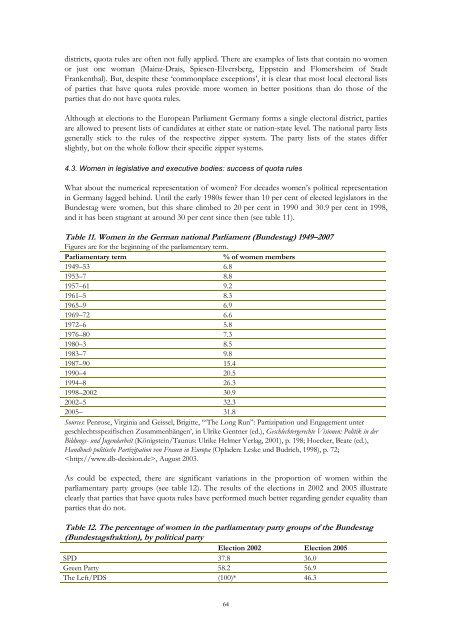Electoral gender quotas systems and their implementation in Europe
Electoral gender quotas systems and their implementation in Europe
Electoral gender quotas systems and their implementation in Europe
You also want an ePaper? Increase the reach of your titles
YUMPU automatically turns print PDFs into web optimized ePapers that Google loves.
districts, quota rules are often not fully applied. There are examples of lists that conta<strong>in</strong> no womenor just one woman (Ma<strong>in</strong>z-Drais, Spiesen-Elversberg, Eppste<strong>in</strong> <strong>and</strong> Flomersheim of StadtFrankenthal). But, despite these ‘commonplace exceptions’, it is clear that most local electoral listsof parties that have quota rules provide more women <strong>in</strong> better positions than do those of theparties that do not have quota rules.Although at elections to the <strong>Europe</strong>an Parliament Germany forms a s<strong>in</strong>gle electoral district, partiesare allowed to present lists of c<strong>and</strong>idates at either state or nation-state level. The national party listsgenerally stick to the rules of the respective zipper system. The party lists of the states differslightly, but on the whole follow <strong>their</strong> specific zipper <strong>systems</strong>.4.3. Women <strong>in</strong> legislative <strong>and</strong> executive bodies: success of quota rulesWhat about the numerical representation of women? For decades women’s political representation<strong>in</strong> Germany lagged beh<strong>in</strong>d. Until the early 1980s fewer than 10 per cent of elected legislators <strong>in</strong> theBundestag were women, but this share climbed to 20 per cent <strong>in</strong> 1990 <strong>and</strong> 30.9 per cent <strong>in</strong> 1998,<strong>and</strong> it has been stagnant at around 30 per cent s<strong>in</strong>ce then (see table 11).Table 11. Women <strong>in</strong> the German national Parliament (Bundestag) 1949–2007Figures are for the beg<strong>in</strong>n<strong>in</strong>g of the parliamentary term.Parliamentary term% of women members1949–53 6.81953–7 8.81957–61 9.21961–5 8.31965–9 6.91969–72 6.61972–6 5.81976–80 7.31980–3 8.51983–7 9.81987–90 15.41990–4 20.51994–8 26.31998–2002 30.92002–5 32.32005– 31.8Sources: Penrose, Virg<strong>in</strong>ia <strong>and</strong> Geissel, Brigitte, ‘“The Long Run”: Partizipation und Engagement untergeschlechtsspezifischen Zusammenhängen’, <strong>in</strong> Ulrike Gentner (ed.), Geschlechtergerechte Visionen: Politik <strong>in</strong> derBildungs- und Jugendarbeit (Königste<strong>in</strong>/Taunus: Ulrike Helmer Verlag, 2001), p. 198; Hoecker, Beate (ed.),H<strong>and</strong>buch politische Partizipation von Frauen <strong>in</strong> Europa (Opladen: Leske und Budrich, 1998), p. 72;, August 2003.As could be expected, there are significant variations <strong>in</strong> the proportion of women with<strong>in</strong> theparliamentary party groups (see table 12). The results of the elections <strong>in</strong> 2002 <strong>and</strong> 2005 illustrateclearly that parties that have quota rules have performed much better regard<strong>in</strong>g <strong>gender</strong> equality thanparties that do not.Table 12. The percentage of women <strong>in</strong> the parliamentary party groups of the Bundestag(Bundestagsfraktion), by political partyElection 2002 Election 2005SPD 37.8 36.0Green Party 58.2 56.9The Left/PDS (100)* 46.364






